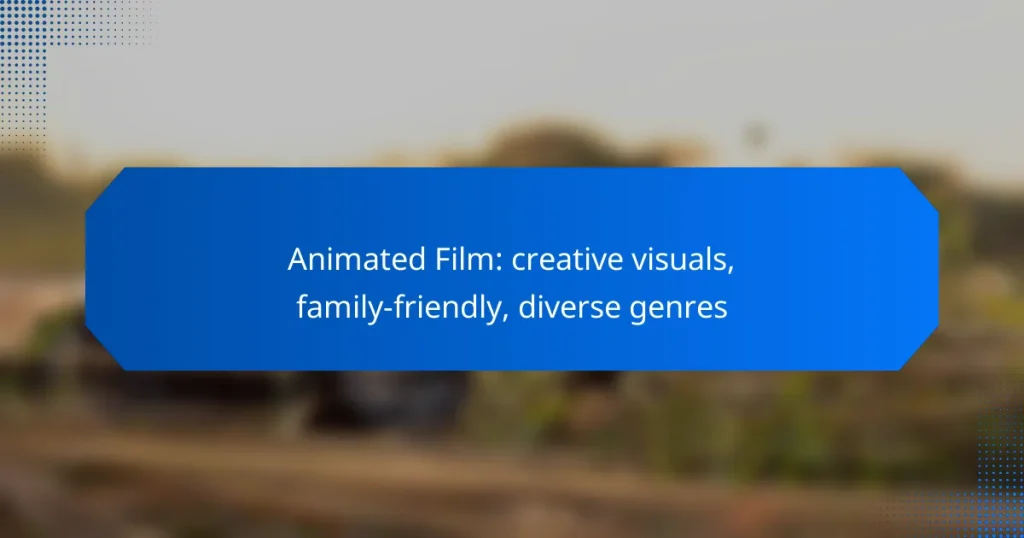Animated films offer a vibrant blend of creativity and storytelling, making them a delightful choice for family-friendly entertainment. With a diverse range of genres, these films captivate audiences of all ages through imaginative visuals and engaging narratives. From whimsical adventures to heartfelt tales, animated features provide a unique cinematic experience that brings families together.

What are the best animated films for families in Canada?
Some of the best animated films for families in Canada include titles that blend creativity, humor, and heartwarming stories. These films cater to a variety of tastes, ensuring that both children and adults can enjoy the experience together.
Pixar’s Soul
Pixar’s “Soul” explores profound themes of purpose and passion through the journey of a middle school music teacher. The film beautifully combines stunning visuals with a jazzy soundtrack, making it appealing to both kids and adults.
Its unique storytelling encourages discussions about dreams and aspirations, making it a great choice for family movie nights. The vibrant animation and relatable characters enhance its family-friendly appeal.
Disney’s Encanto
Disney’s “Encanto” tells the story of the Madrigal family, each member blessed with unique magical gifts, except for the protagonist, Mirabel. This film celebrates diversity and the importance of family bonds, set against the backdrop of colorful Colombian culture.
With catchy songs and enchanting visuals, “Encanto” captivates audiences of all ages. It encourages viewers to appreciate their own family dynamics and the beauty of individuality.
DreamWorks’ How to Train Your Dragon
DreamWorks’ “How to Train Your Dragon” follows the friendship between a young Viking, Hiccup, and a dragon named Toothless. This film combines adventure and humor while delivering messages about acceptance and understanding differences.
The stunning animation and thrilling action sequences make it a favorite among families. Its sequels further develop the characters and themes, providing a rich viewing experience for all ages.

What diverse genres are represented in animated films?
Animated films encompass a wide range of genres, each offering unique storytelling styles and visual experiences. From whimsical fantasies to thrilling adventures, these genres cater to various audiences, making animation a versatile medium for family-friendly entertainment.
Fantasy animations
Fantasy animations transport viewers to magical worlds filled with mythical creatures and enchanting adventures. These films often feature elements like sorcery, fantastical landscapes, and heroic quests, appealing to both children and adults. Popular examples include classics like “The Lion King” and more recent hits like “Frozen,” which showcase imaginative storytelling.
When creating or selecting fantasy animations, consider the balance between whimsical elements and relatable characters. This combination helps engage audiences and creates a sense of wonder while maintaining emotional depth.
Adventure animations
Adventure animations focus on exciting journeys and explorations, often involving brave protagonists facing challenges. These films can range from treasure hunts to epic quests, providing thrilling narratives that captivate audiences. Titles such as “Finding Nemo” and “Moana” exemplify adventure animations that resonate with family viewers.
To enhance the adventure experience, filmmakers should incorporate dynamic pacing and vivid visuals. Engaging soundtracks and character development are also crucial for keeping the audience invested in the journey.
Musical animations
Musical animations blend storytelling with song and dance, creating an engaging experience that appeals to a wide audience. These films often feature original soundtracks that enhance the narrative, making them memorable. Classic examples include “Beauty and the Beast” and “The Little Mermaid,” which have become iconic for their musical numbers.
When producing musical animations, focus on catchy melodies and relatable lyrics that resonate with viewers. A strong connection between the music and the storyline can elevate the emotional impact and encourage audience participation.

How do animated films incorporate creative visuals?
Animated films utilize creative visuals through a variety of techniques that enhance storytelling and engage audiences. These techniques include unique animation styles, diverse color palettes, and thematic elements that resonate with viewers of all ages.
Unique animation styles
Animation styles can vary widely, from traditional hand-drawn techniques to modern 3D computer-generated imagery (CGI). Each style brings its own aesthetic and emotional impact, influencing how stories are perceived. For instance, stop-motion animation offers a tactile quality that can evoke nostalgia, while sleek CGI can create immersive worlds.
Popular examples include the whimsical hand-drawn style of Studio Ghibli films and the vibrant CGI of Pixar. Filmmakers often choose a style that aligns with the narrative, enhancing the overall experience.
Color palettes and themes
Color palettes play a crucial role in setting the mood and tone of animated films. Bright, saturated colors may convey joy and excitement, while muted tones can suggest seriousness or melancholy. Filmmakers often use color theory to evoke specific emotions, guiding audience reactions throughout the film.
For example, films like “Inside Out” use distinct colors to represent different emotions, helping viewers connect with the characters’ experiences. When developing a color palette, consider how it complements the story and supports character development.

What are the top animation studios in Canada?
Canada is home to several prominent animation studios known for their creative visuals and family-friendly content. These studios produce a diverse range of animated films and series that appeal to audiences of all ages.
Studio Ghibli
Although primarily based in Japan, Studio Ghibli has collaborated with Canadian artists and studios, influencing the animation landscape in Canada. Their films are celebrated for their stunning artistry and deep storytelling, often incorporating themes of nature and humanity.
Canadian audiences have embraced Studio Ghibli’s work, with films like “Spirited Away” and “My Neighbor Totoro” becoming classics. The studio’s unique style encourages Canadian animators to explore rich narratives and intricate visuals in their own projects.
Corus Entertainment
Corus Entertainment is a major player in the Canadian animation industry, producing and distributing a variety of animated content. They are known for popular children’s programming, including series like “The Backyardigans” and “Dino Ranch,” which blend engaging stories with vibrant animation.
Corus focuses on creating family-friendly content that resonates with young audiences, often incorporating educational themes. Their commitment to diversity and inclusion is reflected in the range of characters and stories they develop.
Nelvana
Nelvana is one of Canada’s leading animation studios, recognized for producing both animated series and feature films. Founded in the 1970s, they have created beloved shows like “Babar” and “Franklin,” which are staples of children’s television.
The studio emphasizes storytelling that appeals to children and families, often highlighting Canadian culture and values. Nelvana’s work has won numerous awards, showcasing their commitment to high-quality animation and engaging narratives.

What are the trends in animated film production?
Trends in animated film production are increasingly shaped by advancements in technology and a commitment to diverse narratives. Filmmakers are leveraging cutting-edge techniques and exploring a wider range of stories that resonate with global audiences.
Increased use of CGI
The use of computer-generated imagery (CGI) in animated films has surged, allowing for more intricate and visually stunning storytelling. This technology enables filmmakers to create detailed characters and immersive environments that were previously unattainable.
CGI offers flexibility in animation styles, from hyper-realistic visuals to stylized representations. Films like “Frozen” and “Spider-Man: Into the Spider-Verse” exemplify how CGI can enhance storytelling through vibrant aesthetics and dynamic action sequences.
Focus on diverse storytelling
There is a growing emphasis on diverse storytelling in animated films, reflecting a broader range of cultures, experiences, and perspectives. This trend not only enriches the narrative landscape but also appeals to a more varied audience base.
Films such as “Coco” and “Raya and the Last Dragon” showcase cultural authenticity and representation, highlighting the importance of inclusive narratives. Filmmakers are encouraged to collaborate with diverse teams to ensure authenticity and depth in their storytelling.

How do animated films appeal to different age groups?
Animated films attract various age groups by blending engaging storytelling with captivating visuals and humor. They often incorporate themes and elements that resonate with both children and adults, making them enjoyable for families.
Humor for adults
Animated films often include humor that appeals specifically to adults, using clever wordplay, cultural references, and situational comedy. This layered approach allows parents to enjoy the film alongside their children, creating a shared viewing experience.
For example, films like “Shrek” and “The Incredibles” feature jokes that may go over children’s heads but resonate with adult audiences. This dual-layered humor enhances the film’s appeal and encourages repeat viewings.
When creating or selecting animated films, consider the balance of humor types. Ensure that adult humor is subtle enough not to alienate younger viewers while still being engaging for adults. Avoid overly complex references that may confuse children, as the goal is to create a family-friendly atmosphere.


